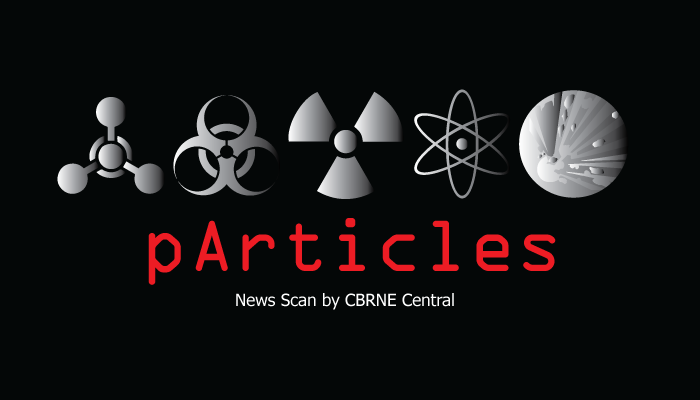Topics in this issue include the Blue Ribbon Study Panel on Biodefense, nuclear R&D funding, smallpox countermeasure stockpiling, and maritime security.
In This Article
Blue Ribbon Biodefense Panel Comments on Biosecurity Incidents
The Blue Ribbon Study Panel on Biodefense this week responded to recent events involving U.S. high-level biocontainment labs and USA Today’s investigative report into these labs. The Panel’s co-chairs expressed grave concerns over the findings of lax safety standards and called on the federal government to strengthen the nation’s lab biosecurity. Global Biodefense >>
US Department of Energy Funding for Nuclear R&D
Sixty-eight projects have been selected to share over $60 million of US Department of Energy (DOE) nuclear energy research and infrastructure enhancement awards. The projects, including some international collaborations, have been selected for their potential to create scientific breakthroughs. World Nuclear News >>
World’s Nuclear Facilities at Risk from Cyber Attacks
Sounding the alarm in front of more than 650 experts from 92 member states, IAEA Director General Yukiya Amano said the inaugural International Conference on Computer Security in a Nuclear World sent “an important message” that the world is finally “serious about protecting nuclear and other radioactive material.” HS Today >>
Could ISIL Go Nuclear?
ISIL has attracted at least hundreds of foreign fighters from Western countries to join its ranks, some with solid academic and educational backgrounds and intellectual knowledge, have joined the cause and continue to do so every day. Furthermore ISIL’s success is based on an effective media strategy of looking at the utmost possible “news effect” of their attacks. NATO Review >>
TSA Airport Worker Vetting: A “Failure” or Media Hype?
The general impression that one gets from the media stories to date is that terrorism suspects have slipped through the cracks and are working at U.S. airports, posing a significant threat to the U.S. aviation system. But that is not what the IG report actually says. Security Insights >>
New Technology Could Better Detect Dangerous Materials at US Ports
It is the stuff of scientists’ nightmares and science fiction writers’ plot points: a nuclear weapon is slipped into the U.S. on a cargo ship and detonates, destroying an American seaport and killing a million people. Indeed, in the movie version of Tom Clancy’s book, The Sum of All Fears, a smuggled bomb destroys Baltimore. Inside Science >>
Countering Nuclear and Radiological Materials Illicit Trafficking Through Maritime Security Initiatives
For more than a decade, the threat of weapons of mass destruction (WMD) terrorism has been on the forefront of the international security agenda. In an increasingly globalized society, detecting and interdicting illicit trafficking of radiological and nuclear (RN) materials to prevent individuals and organizations. CBRNe Portal >>
U.S. Moves Forward with Stockpiling of Second Smallpox Antiviral
The U.S. Department of Health and Human Services (HHS) has announced intentions to procure up to 1.7 million courses of brincidofovir for use in treating individuals with symptomatic smallpox. The contract with Chimerix, Inc. has a total estimated base value of $100M and an anticipated period of 5 years beginning in September 2015. Global Biodefense >>
Avon Protection Acquires SecureBio to Form ‘Avon Training and Consultancy’
Avon Protection, part of Avon Rubber plc, has acquired SecureBio Ltd., the specialist CBRN consultancy it partnered with in 2014. The acquisition of strengthens Avon’s position as a market leader in CBRN protection, and provides a pioneering in-house consultancy service offering specialist risk management, security and training packages to the commercial, media, insurance and counter-terrorism markets. HS Today >>
IAEA Holds First Conference Focused on the Threat of Cyberattacks on Nuclear Facilities
The head of the International Atomic Energy Agency last week called for a global response to potential criminal and terrorist cyberattacks against nuclear facilities. “Terrorists and other criminals operate international networks and could strike anywhere,” IAEA Director General Yukiya Amano said. “So the response must also be international.” Fierce HS >>
Korean Robot Makers Walk Off With 2M Prize
A team of roboticists from the Korea Advanced Institute of Science and Technology claimed a $2 million prize on Saturday that was offered by the Defense Advanced Research Projects Agency for developing a mobile robot capable of operating in hazardous environments NY Times >>
Israel Conducted Tests to Assess the Impact of Dirty Bombs
Between 2010 and 2014, Israeli scientists at the Dimona nuclear reactor conducted a series of experiments, under the code name “Green Field,” to examine the consequences of a dirty-bomb explosion in Israel. The purpose of the experiments was defensive – to measure the likely effect of a dirty bomb and evaluate countermeasures. The experiments did not evaluate to offensive potential of a dirty bomb. HSNW >>
Homeland Security Radio Silence Persists
More than two years ago, an inspector general audit discovered radio silence between the many components of the Department of Homeland Security. Today, little has changed. The department has drafted a communications interoperability plan and management directives to standardize department-wide radio activities. But neither has been finalized. Nextgov >>
IAEA Director General Presents Fukushima Report
An extensive report on the 2011 nuclear accident in Fukushima and two agreements related to the establishment of an IAEA reserve of low enriched uranium were among the key points highlighted by Director General Yukiya Amano in his introductory statement to the Agency’s Board of Governors today. IAEA >>



